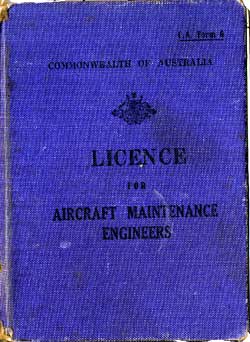Airworthiness Regulation
by Lindsay Wise & Phil Vabre
At
the conclusion of the Great War in 1919, with the influx of aircraft to be used
for civil purposes, the Australian Government introduced a Bill giving effect
to the International Convention for the Regulation of Air Navigation (known as
ICAN) which was signed in Paris on October 13, 1919. As a result the Air Navigation
Act 1920 was passed on December 2, 1920. Regulations were drawn up under the Act
to provide for, amongst other things, the periodical inspection of aircraft and
the licensing of personnel engaged in the maintenance of aircraft. The Act and
associated Regulations came into force on March 28, 1921.

Ground Engineer's Licences were issued under the Air Navigation Regulations in the following categories:
- Division 'A' - Inspection of aircraft undergoing construction or complete overhaul
- Division 'B' - Inspection of aero engines undergoing construction or complete overhaul
- Division 'C' - Inspection of aircraft before flight
- Division 'D' - Installation and inspection of aero engines before flight
- Division 'X' - Inspection and certification of other work
To be eligible to sit for examination applicants had to be 21 years
of age and have had satisfactory practical experience in the maintenance
or overhaul of engines and/or aircraft for which the licence was required.
The 'overhaul' licences were cancelled in the mid 1950s and maintenance
licences only were issued for aircraft, engines, electrical systems,
instrument systems and radio systems. Ratings for each aircraft type
for which the individual is qualified to maintain were, and are, endorsed
on the licence.
Aircraft
Inspectors were appointed to the Civil
Aviation Branch and were the fore-runners of the Aircraft Surveyors
and Airworthiness Surveyors of later years. Today these people are known
as Airworthiness Inspectors and Airworthiness Officers, depending on
their role. They are drawn from the aircraft industry and are required
to hold licences in a least two categories or similar military standards
and demonstrate extensive experience in maintenance of aircraft. Airworthiness
Inspectors are responsible for:
-
licensing of Aircraft Maintenance Engineers and the issue of authorisations for various activities not covered by a licence, e.g. welding, weighing of aircraft, non-destructive testing (NDT) procedures
-
monitoring and surveillance of organisations holding Certificates of Approval for various activities associated with the maintenance of aircraft, together with spot checks on aircraft to ensure that a satisfactory standard is being maintained
- approval of systems of maintenance for aircraft and investigation of aircraft defects
Surveyors also used to be provided with training on new aircraft or equipment introduced by an operator to ensure that their knowledge was continually updated.
Later, Aeronautical Engineers were added to the airworthiness staff. Their responsibility was, and is, approving the manufacture of, and modifications to, aircraft and assessing aircraft performance requirements.
Once
added to the Register, a Certificate of Registration (C of R) is also issued.
In the past the C of R was issued to a person who may not be the owner but was
the person responsible for the continuing airworthiness of the aircraft. From
November 2004, new Civil Aviation Safety Regulations in Part 47 require the C
of R to be issued to an owner, while a new position of Registered Operator is
responsible for the airworthiness of the aircraft.
Following the initial certification of an aircraft type in Australia or overseas, it is issued with a Type Certificate (TC) indicating it conforms to an appropriate design standard. This is usually an international standard, e.g. United States FAA or United Kingdom Civil Aviation Authority.
The process required to operate an aircraft in Australia also includes steps to ensure that the aircraft has been designed and manufactured to appropriate standards Once this is established, by ensuring the aircraft complies with its TC, the aircraft is issued a Certificate of Airworthiness (C of A). Special Certificates of Airworthiness or Experimental Certificates of Airworthiness (and formerly Permits to Fly) may be issued to some aircraft that would not otherwise qualify for a normal C of A. These Certificates or Permits may specify conditions under which the aircraft may be operated. In this context it is also worth noting that there are many aircraft, such as ultralights, that are not registered on the Australian (VH) Register and thus are not covered by the need for a C o f A. They are instead controlled by other bodies such as self-administering sport aviation organisations.
To ensure that it retains an acceptable standard of airworthiness throughout its life, an aircraft is required to be maintained in accordance with an approved Maintenance Schedule or System of Maintenance. The Schedule may be that provided by the manufacturer, one designed by the operator and approved by the civil aviation regulatory authority, or one specified by the authority in regulatory publications. Included in the system are periods at which maintenance, e.g. inspections, tests, component changes, is to be carried out.

All
defects which may significantly affect the airworthiness of an aircraft must be
reported to the regulatory authority as soon as possible. In recent times this
reporting requirement has also been extended to the TC holder. In the past defects
would be investigated by an Airworthiness Surveyor and in consequence might be
considered as a basis for promulgation of a mandatory replacement, modification
and/or inspection requirement by means of an 'Airworthiness Directive'. These
days the TC holder may also promulgate corrective work by means of a Service Bulletin,
compliance with which is mandatory. Aircraft and component manufacturers also
issue service information such as 'Service Instructions' which contain recommendations
as to when certain work should be carried out. In the case of significant items
these may be also adopted as an Airworthiness Directive by the regulatory authority.
Back to the
main Airworthiness & Manufacturing
index
Back to the main Industry Regulation and Aviation Policy index
If
this page appears without a menu bar at top and left, click
here